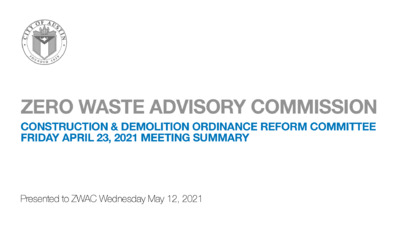Backup — original pdf
Backup

ZERO WASTE ADVISORY COMMISSION CONSTRUCTION & DEMOLITION ORDINANCE REFORM COMMITTEE FRIDAY APRIL 23, 2021 MEETING SUMMARY Presented to ZWAC Wednesday May 12, 2021 Meeting Summary ZWAC Attendees: Cathy Gattuso, Amanda Masino, Ian Steyaert • Citizen Communication • 4 speakers—representing a local recycling business, industry organization, and a non-profit • Some key issues (& various opinions) • certification • enforcement • wood as fuel • Approved February 28, 2017 minutes • New Business • Staff briefing on committee bylaws—Selene Castillo (ARR) • Staff briefing on existing C&D Recycling Ordinance requirements—Elizabeth Nelson (ARR) C&D Recycling History • Austin Energy Green Building • Initial commercial checklist in 1995, included strategies to reduce waste • 2009 – C&D Ordinance development began • 2016 – C&D Ordinance went into effect What IS C&D? Estimated 20% of total waste stream • Wood • Cardboard and Paper • Metals • Concrete • Asphalt • Stone, Brick, Porcelain • Plastic • Trash Material Handling • Commingled Processing • Hand sorted • Mechanically sorted • Combination • Source Separated • High value materials Austin’s Construction and Demolition Recycling Ordinance • Ch 15-6 Article 9 – Construction and Demolition Materials Diversion Program [Solid Waste Code] • Ch 25-11-39 - Construction and Demolition Materials Diversion [Land Development Code] Ordinance Requirements Affected Projects: > 10/1/16: > 5,000 sq ft of new or remodeled floor area > 10/1/19: Commercial and multifamily demolition projects Diversion requirements, either: • Divert ≥ 50%, or • Dispose ≤ 2.5 lbs / sq ft Post-Construction Report online Waiver Request: if materials are non-recyclable Qualified Processors • Commingled C&D Processors • Optional • 3rd party verified facility diversion rate (through RCI or City registered evaluator) • Simpler reporting for contractors Processing and Disposal • Commingled materials are sorted through automated or manual processes, or a combination • Material disposed in Type I (MSW) or IV (C&D) landfills • Processors are not required to register with COA • Regulated by TCEQ • Haulers take material to either in-house or 3rd party processor or landfill 2020 Economic Impact Study on C&D Recycling Key Findings: • Minimal economic impact to affordability • Data from demolition projects insufficient (effected in 2019) • Low reporting rate may skew diversion data upward • Processors able to handle increased volume, if key materials are not contaminated • 3rd party haulers struggle to compete due to limited processing facility access C&D Ordinance Data 2021 10% 61% 0.15 Submission Rate Average Diversion Rate (50% min) Average lbs per Sq Ft Disposed (2.5 max) Waiver Approval Rate N/A 2020 16% 59% 3.94 74% 2019 13% 67% 0.07 50% Data is self reported to ARR from ordinance affected projects. Does not include AEGB project data. Key Takeaways • Low project submission rate • Multiple outreach channels used; outreach increased in recent years • Limited reporting result in lack of data • Lack of enforcement options • ARR Compliance team actively being formed • Changing markets for C&D Materials • Lack of markets for materials (gypsum, asphalt shingles) • Conflict with department master plan and “burning for fuel” being allowed with RCI certification • Contaminated loads rejected by processors Future Agenda Items Next meeting expected: June, 2021 • Recommendations to address issues brought up by speakers and for key decision points we should consider when recommending changes to the C&D ordinance (e.g. impact of burning fuel pellets vs. recycling) • Other cities’ C&D recycling processes as case studies • RCI certification allowing biomass burning and how it differs from the City’s Comprehensive plan • Material end markets that are realistic and environmentally sound • C&D ordinance education